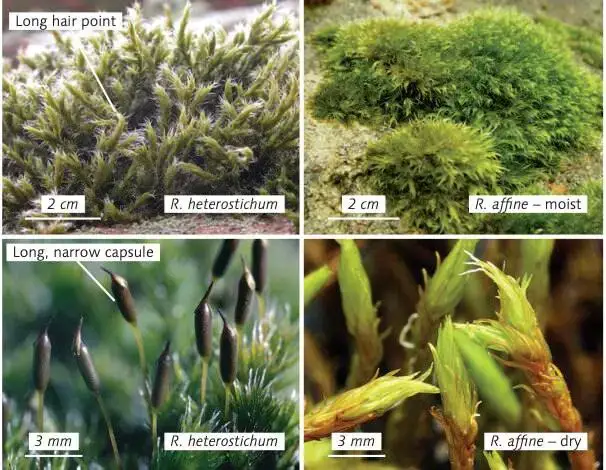
193713.jpg from: https://inpn.mnhn.fr/espece/cd_nom/5580
Introduction
In the vast and captivating world of bryophytes, one particular moss species stands out for its resilience and adaptability – the Racomitrium heterostichum (Hedw.) Brid. moss, belonging to the Grimmiaceae

63381924.jpg from: https://observation.org/photos/63381924/
family. Often referred to simply as Racomitrium, this unassuming yet remarkable plant has captured the hearts of moss enthusiasts worldwide.
Background
Before delving into the intricacies of this fascinating moss, let’s set the stage with some essential background information. Bryophytes, a group that includes mosses, liverworts, and hornworts, are among the oldest land plants on Earth, dating back over 400 million years. These diminutive yet mighty organisms play crucial roles in various ecosystems, acting as pioneers in colonizing barren landscapes and contributing to soil formation.
Main Content
Morphology and Identification
Racomitrium heterostichum is a tufted, acrocarpous moss that forms dense cushions or mats. Its stems can reach up to 10 centimeters in height, and the leaves are lanceolate, keeled, and often curved when dry. One of the most distinctive features of this moss is its hair-like awns that protrude from the leaf tips, giving it a unique and easily recognizable appearance.
Global Distribution and Habitat
This resilient moss species has a widespread distribution, found across various regions of the Northern Hemisphere, including Europe, Asia, and North America. It thrives in a diverse range of habitats, from exposed rock surfaces and cliffs to tree bark and soil, showcasing its remarkable adaptability.

large.jpg from: https://www.inaturalist.org/guide_taxa/298321
Ecological Roles and Adaptations
Racomitrium heterostichum plays a vital role in its ecosystems, acting as a pioneer species in colonizing bare rock surfaces and contributing to soil formation. Its ability to withstand desiccation and extreme temperatures is nothing short of remarkable, thanks to its unique adaptations. The hair-like awns on its leaves help to reduce water loss and protect the plant from excessive sunlight, while its dense cushion-like growth form provides insulation and retains moisture.

50912417803_d51d2dd255_b.jpg from: https://www.flickr.com/photos/154525892@N05/50912417803/
Case Studies/Examples
One fascinating example of Racomitrium heterostichum‘s resilience can be found in the Arctic regions, where it thrives on exposed rock surfaces, defying the harsh conditions of extreme cold and wind. In these unforgiving environments, the moss forms dense mats that provide shelter and habitat for other organisms, contributing to the overall biodiversity of the ecosystem.
Technical Table

Racomitrium_heterostichum_003.JPG from: https://cisfbr.org.uk/Bryo/Cornish_Bryophytes_Racomitrium_heterostichum.html
| Characteristic | Description |
|---|---|
Scientific Name
 43063704.jpg from: https://waarneming.nl/waarneming/view/225944881?_popup=1 |
Racomitrium heterostichum (Hedw.) Brid.
 2021-12-20-13-57-38-800×600.jpg from: https://www.britishbryologicalsociety.org.uk/learning/species-finder/racomitrium-heterostichum/ |
| Family | Grimmiaceae |
| Growth Form | Tufted, acrocarpous |
| Leaf Shape | Lanceolate, keeled, curved when dry |
| Distinctive Feature | Hair-like awns on leaf tips |
| Habitat | Rock surfaces, cliffs, tree bark, soil |
| Distribution | Northern Hemisphere (Europe, Asia, North America) |
Conclusion
The Racomitrium heterostichum (Hedw.) Brid. moss, a true marvel of the Bryophyta world, serves as a testament to the incredible resilience and adaptability of these often-overlooked organisms. As we continue to explore and appreciate the wonders of the natural world, let us ponder this thought-provoking question: What other remarkable adaptations might we uncover in the intricate tapestry of life, waiting to be discovered and marveled at?

m-42a1.jpg from: https://www.irishwildflowers.ie/pages-moss/m-42.html

24825820.jpg from: https://waarneming.nl/observation/185253660/

il_fullxfull.3725069001_qlpt.jpg from: https://www.thebryophytanursery.com/listing/1181249739/terrarium-moss-racomitrium-heterostichum